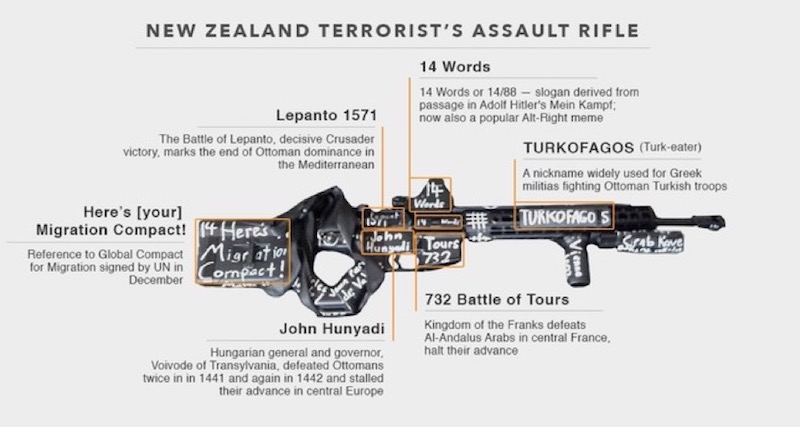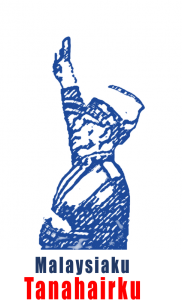Raggie Jessy Rithaudeen
Barelly has the dust settled on the terror attacks at New Zealand’s Christchuch mosques, newly-surfaced photos courtesy of The Washington Post revealed a sordid truth that painted an even darker picture: one of the gunmen painted his weapon – a military styled semi-automatic bearing an A class gun licence – with names of “idols” that bore uncanny references to the Christian crusades against Muslims, Turks and Ottomans.

Meanwhile, letters and numbers from the Latin, Cyrillic and Georgian (Mkhedruli) alphabets, words and dates related to places, people and battles associated with violent conflict throughout history between Christians and Muslims could be seen on all weapons, indicating that the massacre wasn’t just premeditated, but an act of terror designed to incite unrest by provoking peace loving Muslims.

Following is a list of some historical figures the assailant chose to display on his assault rifle:
1. Charles Martel
Charles Martel was the King of Francia (Modern day France), known in European history for putting a halt to the Islamic Caliphates’ advance into Western Europe during the battle of Tours in 732 CE. For this reason, he is revered and accorded a divine status in Christian evangelical and orthodox teachings.
2. Tours 732
The Battle of Tours, 732 CE, was perhaps the most defining battle in the history of Europe. Muslim forces of the Umayyad Caliphate completely crushed the Christian Kingdoms of Spain and conquered all of the European nation before conquering all of Western Europe. If we compare the balance of power during the time, the Ummayad Caliphate was the worlds sole superpower and was far more advanced militarily and technologically than the Christian Kingdoms of Europe. The only Kingdom that was somewhat capable to put up a resistance to the mighty Caliphate in all of Europe was the Kingdom of Francia (France).
Initially, the battle went very well for the Muslims – the Caliphate was almost victorious, with the entire European region up for its taking. But its soldiers gradually got greedy seeing the war booty and wealth lying in the battlefield and broke ranks with commander Abdul Rahman Al Ghafiqi. Seeing this, the Christian forces rallied and caught the unarmed Muslims offguard as most of them had put down their weapons to loot the battlefields. Shocked, the Caliphate’s soldiers fled and left the brave Abdul Rahman Al Ghafiqi alone to wage a valiant and fierce charge against the Franks before embracing martyrdom.
Not many are aware, that had the Muslims won the battle of Tours, they would have conquered all of Western Europe.
3. Vienna 1683
The battle of Vienna in 1683 CE was the last Jihad offensive in history to be led by an Islamic Caliphate. The Ottoman Caliphate in the 16th century was a world superpower in its own right, what with its huge army and military might that went unmatched. From the early years of its foundation, the Caliphate waged endless conquests that spread its dominion throughout the greater part of Europe with great ease. That didn’t go down well with the Pope, who initiated many Crusades and engendered countless Christian coalitions to stop the Ottoman advance. Still, even with all of Europe united, they were unable to stop the rise of the Ottoman Empire.
Not long after, the Ottoman army besieged the city of Vienna, known then as the ‘heart of Europe’, with a mighty army of 300,000 soldiers. However, the Ottomans lost the battle due to Commander Kara Mustapha’s arrogance and disobedience to the Sultan’s orders. While Kara did pay the price when the Sultan ordered his execution, the damage was done – the defeat was catastrophic enough for the Muslim world that it triggered the gradual decline of the Ummah. And since there never was an offensive or war thereafter significant enough to spread the teachings of Allah, technological innovations and thinking from the Muslim world gradually fell apart and led to Christians taking credit for innovation by Muslims.
4. Calivijo 844
According to sources from Spanish Churches, the Battle of Calivjo was a great ‘victory’ for the Christians over the Muslims. However, most modern day European Historians have since declared that no such battle took place, that it was a myth made up by the Church of Spain to boost Christian hatred towards the Muslims. There is no historical evidence of it.
The most hilarious part about the whole affair is when the Spanish Church ‘roped in’ the apostle James, son of Zebedee and a companion of Jesus who died 800 years earlier, who miraculously ‘reappeared’ and led the Christian army towards victory.
5. Odo the great
Odo the ‘Great’ was the ruler of the state of Aquitaine in France in the early 700s. He was known in the European world as the first Christian king to defeat the Umayyad Caliphate in 721 CE in a fiercely fought battle that earned him the epithet ‘the great’. However, in 732 CE, he was humiliated by Abdul Rahman Al Ghafiqi in the Battle of the River Garonne which marked yet anther Muslim uprising against the advances of orthodox Christian rulers who were radical and extremist in their ways.
6. Alexandre Bissonnette
Alexandre Bissonnette is the name of the terrorist who carried out the The Quebec City mosque shooting in Canada on the 29th of January, 2017.
7. Skanderbeg
Skanderbeg (1405-1468) was an Albanian nobleman who served initially with the Ottoman Empire but detracted before leading a rebellion against the Ottoman Sultanate. Lacking skills in regular militaristic methods, he resorted to guerrilla warfare and ended up causing much headache for the Ottoman province of Albania. He was so cruel to Muslims, it is said that he used to even torture children in front of their naked mothers. So ruthless and blood thirsty was he that even the Christian nobles who joined his rebellion later requested Sultan Mehmed II to get rid of his tyranny. Thankfully, the Sultan stopped him in his tracks and prevented the Ottoman advance from derailing.
8. Anton Lundin Pettersson
Anton Lundin Pettersson is the terrorist who carried out the Trollhättan school attack in Sweden on the 22nd of October 2015. He was a 21 year old who was radicalized by extremist Christians and went on to kill children in a school where the majority were Muslims.
9. Marco Antonio Bragadin
Marco Antonio Bragadin (21 April 1523 – 17 August 1571) was a military officer in the Republic of Venice. In 1569, he was elected as Captain of the Kingdom of Cyprus and moved to Famagusta. From there, he waged attacks on ships ferrying Muslim pilgrims to Mecca and Medina. The captured Muslims prisoners were tortured and mercilessly executed. On the 17th of September 1570, the Ottoman navy besieged the city of Venice before executing Marco for the crimes he committed towards Muslims.
10. Kebab
The modern terminology of ‘Kebab’ is a derogatory term for Muslims. It was used during the Ottoman times by the Christian states to refer to the Ottomans since the Ottomans invented the Kebab. It is quite like the case of the non-Indians in Malaysia referring to the Indians as ‘pariah’.
11. For Berlin, For Madrid
These are references to the attacks carried out by ISIS in the city of Berlin and Madrid.
Other notable mentions include:
12. Luca Traini
Luca Traini was an Italian extremist who targeted black migrants, injuring six in February 2018.
13. Josue Estebanez
Josue Estebanez was a Spanish neo-Nazi who fatally stabbed 16-year-old anti-fascist protester Carlos Palomino in the heart in Madrid in 2007.
14. Bajo Pivljanin
Bajo Pivljanin was a famous 17th-century hadjuk (militia) commander who fought against Ottoman rule in the northwestern Balkans and was hailed a “hero” by Serbs and Croats.
15. Pelayu
Pelayu was a Visigothic nobleman instrumental in the victory at the Battle of Covadonga. He is credited with starting the Reconquista (the Christian reconquest of the Iberian peninsula from the Moors).
16. Prince Fruzhin
Prince Fruzhin was a Bulgarian noble who fought against Ottomans in the conquest of the Second Bulgarian Empire.
So you see, as evident from some of the writings found on the assailant’s gun (as listed above), the attack may have been an act of Christian extremism and was most certainly driven by religious fanaticism.
Click on the button below, or send a WhatsApp to +60164049082 if you intend to make a direct contribution to our account. We thank you for your support and hope to continue bringing you great content in the years to follow.
FOLLOW US ALSO VIA THE FOLLOWING LINKS:
Raggie Jessy Rithaudeen on Twitter
The Third Force on Twitter
Raggie Jessy Rithaudeen on Facebook
TowardsGE15 on Facebook
Gagasan Tiga (G3) on Facebook
The Third Force (Telegram)




